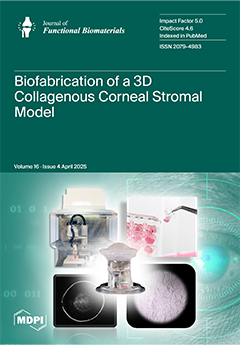Background: Sinus-lift (SL) is a pre-prosthetic procedure with the objective of increasing bone height to achieve implant insertion primary stability in implant-supported prostheses. The biomechanical properties of SL augmentation materials are influenced by their origin, manufacture, bioactive substances addition, receiver, and surgical procedure.
[...] Read more.
Background: Sinus-lift (SL) is a pre-prosthetic procedure with the objective of increasing bone height to achieve implant insertion primary stability in implant-supported prostheses. The biomechanical properties of SL augmentation materials are influenced by their origin, manufacture, bioactive substances addition, receiver, and surgical procedure. This systematic review provides insights into state-of-the-art SL biomaterials, focusing on autologous bone grafting as the gold standard. Methods: The study followed the PRISMA flow diagram, searching WoS (Web of Science), Embase, Cochrane, and PubMed databases using the search terms «sinus lift» OR «sinus augmentation» OR «bone graft» OR «bovine» OR «porcine» OR «autologous» OR «allogenic» OR «xenogeneic» OR «alloplastic» OR «hydroxyapatite» OR «β-tricalcium phosphate (β-TCP)» OR «equine» OR «PRF». Results: The highest bone gain was provided by Bioglass at 42%. Articles written between 2014 and 2024 in English or French, containing human studies and with full text available, were included. Participants were required to be in good general health, without acute, chronic, or congenital diseases, or substance abuse (drugs, alcohol, or nicotine). SL surgery was performed using the lateral approach, with no Schneiderian membrane perforation or postoperative complications. The network meta-analysis was conducted using the R statistical computing environment. To assess the inconsistency between direct and indirect evidence, we used a net heat plot. To evaluate heterogeneity across studies, we used the chi-squared-based Q-test and I
2 statistic. A significance level of 0.05 was applied throughout all analyses. Results: Allogeneic bovine bone and hydrox yapatite demonstrated the lowest resorption rates. Significant differences were found for residual graft and connective tissue between allogenous bovine bone (ABB) + AlB vs. β-TCP + PRF (
p = 0.028); ABB + AlB vs. β-TCP (
p = 0.034); ABB + AlB vs. BCP (
p = 0.037). Meta-analysis showed that the overall heterogeneity was 51.8% (6.9–75%;
p = 0.019), with significant heterogeneity within designs (
p = 0.007) and no significant heterogeneity between designs (
p = 0.39). AB had a better bone regeneration ratio compared to many of the other interventions, but only two passed the threshold of significance: A1B and B-TCP + AB. Conclusions: A grafting material’s superiority is determined by its new bone formation ratio, connective tissue integration, residual graft content, and bone resorptionratio. Although autologous bone grafting has exhibited superior bone regeneration compared to other biomaterials, it was not favored due to its unpredictable connective tissue concentration and bone resorption ratio. Additionally, autologous bone exhibited the fastest metabolic turnover among all grafting materials.
Full article






